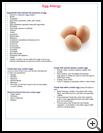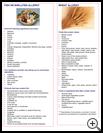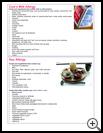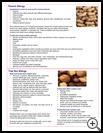
Food Allergy: Foods to Avoid
________________________________________________________________________
KEY POINTS
- A food allergy is a condition in which your child’s immune system reacts to certain foods as though they are harmful. An allergic reaction may include a rash, itching, swelling, irritation, and tight muscles in your child's airways that make it hard to breathe.
- The 8 foods that are responsible for most food allergies in children include milk, soy, eggs, peanuts, tree nuts (such as walnuts and cashews), wheat, fish, and shellfish.
- Completely avoiding the food that causes the allergy is the only way to prevent a reaction.
________________________________________________________________________
What is a food allergy?
An allergy is a reaction your child’s body has to things it sees as harmful. Sometimes the body’s immune system reacts to certain foods as though they are harmful. The immune system tries to protect your child by making antibodies. These antibodies cause the body’s cells to release chemicals such as histamines. These chemicals cause a rash, itching, swelling, irritation, and tight muscles in your child's airways that make it hard to breathe. Children who have asthma have an increased risk of severe or life-threatening reactions.
What are the most common food allergies?
The 8 foods that are responsible for most food allergies include milk, soy, eggs, peanuts, tree nuts (such as walnuts and cashews), wheat, fish, and shellfish. Many children grow out of food allergies to eggs, milk, wheat, or soy, but other allergies may be lifelong.
If you have a family history of allergies, ask your child's healthcare provider about the right age to introduce peanuts and other foods that your child may be allergic to. Your provider can tell you if this should be done in the provider's office or if it is safe to do at home. Some studies suggest that introducing foods at 4 to 6 months may help prevent severe allergies in children.
- Peanuts and tree nuts: Nuts such as walnuts, almonds, pecans and cashews are called tree nuts because they grow on trees. Peanuts grow underground. About half of children with a peanut allergy are also allergic to tree nuts.
- Soy: Soybeans are in the legume family (kidney beans, lentils, peas, and peanuts). Some children are allergic to more than one type of legume. Avoiding soy can be difficult as soybeans are used in many processed foods found in the United States. Most children with a soy allergy may safely eat soy lecithin and refined soybean oil.
- Wheat: There are 4 types of protein found in wheat (albumin, globulin, gliadin, and gluten). Your child may be allergic to any one of these proteins. Children with a wheat allergy may also react to oats, rye, and barley. Wheat allergy is often confused with celiac disease. Celiac disease is a digestive problem that causes the body to react to gluten, which is also found in barley and rye grains.
If your child is allergic to one food, he or she may be allergic to others. Ask your healthcare provider or dietitian if your child needs to avoid other foods.
What kind of formula should I use?
If your infant is only allergic to soy, you can use regular (non-soy) baby formula. However, about half of the children with a milk allergy are also allergic to soy. If your child is allergic to both soy and cow’s milk, you will need to switch to a low allergy formula. There are two types:
- Extensively hydrolyzed formulas: The proteins in these formulas have been broken down so they are less likely to cause a reaction. Examples include Nutramigen, Pregestimil, and Alimentum. Partially hydrolyzed formulas are not a good substitute.
- Elemental formulas: The proteins in these formulas are in the simplest form and are used when hydrolyzed formulas cause symptoms. Elemental formulas include Neocate, EleCare, and PurAmino.
How can I prevent allergic reactions?
Completely avoiding the food that causes the allergy is the only way to prevent a reaction. You will need to change the way you shop, prepare, and order foods. You can get cookbooks for people with food allergies. There are also websites that sell foods for people with allergies. Ask your child's dietitian for ideas about food substitutes.
If you are breastfeeding, do not eat the food your child is allergic to. Food allergens from the foods you eat can enter your breast milk.
It is important for you to know which ingredients may cause problems if your child has a food allergy. The first step is to learn to read labels and get to know which ingredients contain allergens. Foods that contain milk, eggs, fish, shellfish, peanuts, tree nuts, wheat, or soy products must list the food in plain language on the ingredient list. These possible allergens must be listed even if they are part of a flavoring, coloring, or spice blend. Here are some things to remember when reading food labels:
- Read the label every time. Ingredients may have changed since the last time you bought the product.
- Watch out for the words “may contain.” Peanuts may not be an ingredient, but the food may be made in a factory that also produces other foods that contain nuts. If you see the words “may contain,” there may be very little of the allergen, or there may be a large amount.
- Words on the package such as “wheat-free” do NOT mean that the food is completely free of wheat. It may contain tiny amounts.
When dining out:
- Avoid salad bars and buffets because food, dishes, and serving items may have been in contact with other foods.
- Order simple dishes with only a few ingredients. Avoid sauces unless you're sure they don't contain allergens.
- Tell the server about your child’s food allergy.
- Ask if food processors, cutting boards, pans, knives, or other kitchen equipment are used for other foods.
Always ask about ingredients if you are not sure.
How can I keep my child safe at daycare or school?
What your child can do
Children as young as 4 or 5 can be taught that they have a part to play in managing their food allergies. Give your child simple rules such as:
- Do NOT trade food.
- Do NOT eat food unless it comes from home.
- Tell an adult RIGHT AWAY when you think you ate a food that you are allergic to.
- Always wear your Medic Alert bracelet or necklace.
When your child can read, teach him or her how to read labels on packages.
What caregivers, teachers and classmates can do
- Write an Action Plan. List all the information about your child's food allergy and how to respond to an allergic reaction. Have your child’s healthcare provider sign the paper.
- Give the caregiver or school staff a list of ingredients that your child needs to avoid, and a copy of the Action Plan.
- Children who have had life-threatening allergic reactions before should follow their provider’s directions to keep epinephrine shots and an antihistamine (such as Benadryl) with them at all times. If your child is very young, give your child's medicine to the caregiver, teacher, or school nurse. Make sure they have written instructions for how to store it, and how and when to use it. Make sure they always know where the medicine is located.
- Talk to your child’s class or make a presentation about food allergies.
- Ask your child’s teacher to tell you in advance about any parties or art projects that involve foods. Ask your child’s teacher to keep foods your child can eat in the classroom in case the teacher forgets to tell you about an activity or event.
What your child’s school can do
- Some children have severe allergic reactions to very tiny amounts of peanuts, peanut dust, or other nuts. Many schools set up nut-free tables in the lunchroom. It is best to let any child sit at the nut-free table, as long as their lunches don't contain peanuts or tree nuts. This lets your child sit with friends and still be safe. Make sure that the school staff also watches for bullying. Some children with allergies have been bullied by other kids throwing peanuts or holding granola bars close to their faces.
- Volunteer to help with snacks and party treats.
- Send your child to school with a treat he or she can eat if the class is having something that your child cannot eat.
- Ask for "no eating" policies on buses and other areas where students may not be supervised.
To learn more, contact:
- Food Allergy Research & Education (FARE)
https://www.foodallergy.org/
800-929-4040 - Kids with Food Allergies Foundation
https://www.kidswithfoodallergies.org - The American Academy of Allergy, Asthma and Immunology
https://www.aaaai.org/
Last modified: 2021-06-25
Last reviewed: 2019-04-01




